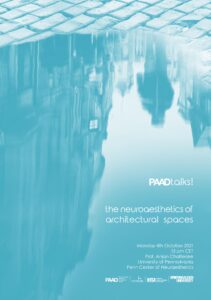
- Diese Veranstaltung hat bereits stattgefunden.
Chatterjee: The neuroaesthetics of architectural spaces
Anjan Chatterjee
Penn Center of Neuraesthetics
University of Pennsylvania
 Zoom-Meeting-ID: 967 2780 6048
Zoom-Meeting-ID: 967 2780 6048
Password: 747785
Direct link: https://rwth.zoom.us/j/96727806048?pwd=MjlOT1YrNk1ZUGZWTEV3ZU1BS0VGUT09
People in developed countries spend over 90% of their time in built environments. Yet, we know little about its pervasive and often hidden effects on our mental state and our brain. Despite growing interest in the neuroscience of architecture, much of this scholarship has been descriptive. The typical strategy is to map knowledge of the brain onto constructs important to architecture. For a programmatic line of research, how might we transform descriptive neuroarchitecture into an experimental science? I will describe our efforts to do exactly that. We hypothesized aesthetic responses to architectural interiors reduce to key psychological dimensions and that these psychological dimensions evoke specific neural markers. Using Psychometric Network Analysis (PNA) and Principal Components Analysis (PCA) and responses to curated images, we identified three components: coherence (ease of organizing and comprehending a scene), fascination (informational richness and generated interest), and hominess (personal ease and comfort). Coherence and fascination are well-established dimensions for natural scenes. Hominess was a new dimension related to architectural interiors. Central to all three communities in the PNA was emotional valence. We also reanalyzed data from an earlier fMRI study in which participants made beauty and approach-avoidance decisions while viewing the same images. Regardless of task, the degree of fascination covaried with neural activity in the right lingual gyrus. In contrast, coherence covaried with neural activity in the left inferior occipital gyrus only when participants judged beauty, and hominess covaried with neural activity in the left cuneus only when they made approach-avoidance decisions. The visual brain harbors hidden sensitivities to architectural interiors that are captured by the dimensions of coherence, fascination, and hominess. I will conclude by describing challenges for experimental neuroarchitecture and how we might move forward.

